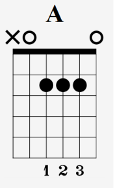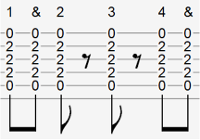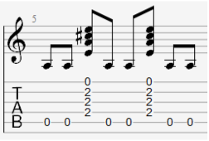Ever wonder why so many great song riffs are simple, but sound so good? How do they even come up with that stuff?
We hear memorable riffs by bands like Nirvana and AC/DC ... things that are so simple, yet you can probably recognize the song in the first few measures.
And what drives these memorable sounds? One word: creativity.
Our heroes are very good at using the things that they already know and getting creative with them.
AC/DC is my favorite example. They mostly use the same 3 chords in different keys, most of which are simple open chords, yet they draw attention with their sophisticated rhythms and interesting modulations all throughout one kick-ass song. That’s how they got their signature sound: they took a simple idea and (pardon my language) abused it. :)
Imagine how many ideas you can get by using 4 chords... or 5, or 6... There are virtually unlimited variations.
But let’s start simple, and get creative with only one chord.
Let’s take a simple A major chord and see what we can do with it.

Style of playing
First things first. How are we going to play it?
Let’s see, we can strum it as a whole, using different rhythms. Just by using different rhythms, we can create interesting riffs.
Take a look at this example: 1 & 2, 3, 4 &. This is not something you would hear on the radio every day. It’s simple and memorable, using a single A chord.

You can come up probably with many more variations yourself. Just try it out.
Also, why not strum different strings at different times? This gives us even more possibilities to try out. Take a look at this next example, where accents are made by strumming the whole chord, but the rest of the measure is filled with one string:

We can also arpeggiate it (playing one note at a time). You have 5 strings available, now how many variations do you think you can make out of it?
Take a look at the next couple of examples. They vary in pitch range, contour (directions of where the notes go) and rhythm. The last one looks very simple, but if you play it, you’ll hear it’s very melodic and memorable.

I’m sure there are other ways to play A chord, but for the sake of simplicity, let’s stop here. As you can see, just by changing what you play and when, you have so many different possibilities by playing only one chord.
Embellish it
You can change the chord you already know by simply leaving out some fingers and therefore creating new chords.
By leaving the second string open, we get something we call an Asus2 chord.

By leaving out the third string, we get an A7 chord.

If you don’t press the note on the fourth string, we get an Aadd11 chord, or Dmaj9 with A in the bass.

You can also combine the options. Very cool sounds, don’t you think?
By adding notes, things can get even more interesting. Let’s add fret 3 on the second string. We get an Asus4 chord:

If we go even a step higher we get an even more interesting sound, we usually call the “lydian” chord:

The good news is, you don’t have to know the names of these fancy chords. You can simply play around with the idea and find things that sound best to you, and use them in your playing.
If we combine these things together, you can get some pretty cool guitar riffs, that you can play either on acoustic or electric guitar:

If you add different styles and rhythms we talked about before, you can see the options are limitless.
Add melodies or bass lines
If you can come up with simple melodies, you can attach them to your chords. You can either play one after the other, or play the melody and the chord at the same time. A good example of playing it at the same time would be The Beatles - Norwegian wood.
Adding a bass line to the chord can also work wonders. All you have to do is add a couple of lower notes to the chord, and make interesting riffs out of that. Depending on the feeling you want in your song, it can be either ascending or descending. Here is an example of both:

As you can see, there are so many options, even if you only play around with one chord. Adding more chords to the equation would leave you with endless possibilities and tons of fun.
If you want your guitar playing to sound more creative, just explore the things you already know. And that counts for basically any style of playing, and anything new you learn. I hope that this simple lesson gives you hope and more inspiration to create awesome music. Good luck!
©Janez Janežič, 2023
About The Author:
Janez Janežič is a creative guitarist and guitar teacher from Slovenia. If you are looking for great rhythm guitar lessons in Novo mesto, be sure to give him a call.